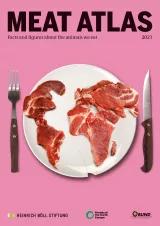
All animal products have a water footprint: the amount of water needed to produce them. It is not just the total amount that is important, but the types of water that are needed. There is enough “green” water. But the volumes of “blue” and “grey” water should be kept low.

In general, more water is needed to produce meat than plant-based foods such as grains or beans. The average water footprint per calorie for beef is 20 times that of grain. But not all meat is the same, and the species of livestock and the management type affect the water requirements considerably.
Producing a kilogram of beef takes an average of 15,415 litres of water. The same amount of sheep or goat meat takes almost 9,000 litres, a kilo of pork 6,000 litres, and of chicken 4,300 litres. In all, 92 percent of the global water footprint goes towards agriculture, 29 percent of which is used in animal production. According to another calculation, agriculture uses 70 percent of all available fresh water, three times as much as 50 years ago.
But one beefsteak is not necessarily the same as another. The precise water footprint depends on the production system in which the animal was raised. Was the animal kept on pasture in a mixed system that included crops, or was it in an industrial system with high animal numbers per hectare, in which over 90 percent of the feed is brought in? Just as important are the composition and origin of the feed.
Here’s an example. The calculation that a kilogram of steak requires 15,415 litres of water assumes that the animal was slaughtered at three years of age. During its lifetime, it will have eaten 1,300 kilograms of feed concentrate composed of various cereals and soybeans, plus 7,200 kilograms of roughage (grass, hay, silage). It will have drunk 24,000 litres of water. Its housing must also be cleaned and sprayed. But most of the water goes into producing the feed.
In making these calculations, we must remember that a cow that has spent its life on a pasture in a humid region will have a relatively large water footprint because the ample rainfall on its pasture is credited to the animal. Plus, it uses its pasture feed fairly inefficiently and takes a long time to reach slaughter weight. This means we should look at the water footprint more closely.
Experts distinguish between “green”, “blue” and “grey” water. Green water is the rainfall that is available to plants from precipitation. Blue water is the volume needed for irrigation. Grey water is the volume that would hypothetically be needed to dilute contaminants to a harmless level so they would comply with limits for water quality.
When calculating the water footprint of meat production, we must know whether it arises from green, blue or grey water in order to judge whether the limited water available is being overexploited. Yes, two-thirds of the Earth’s surface is covered with water, but most of it is salt water in the oceans. Only a tiny proportion, 0.4 percent, is fresh water that circulates in local, regional and global water cycles and is available to plants, animals, and us.
Because cattle kept in industrial systems convert their feed concentrate relatively efficiently, they generally have a smaller water footprint than cattle kept in other systems, including ecological production where the animals spend a lot of time out grazing. But industrial systems rely on feed from arable crops that are irrigated, fertilized and sprayed with pesticides. That means that the footprint for feed production for industrial livestock raising includes a large proportion of blue and grey water. The blue water footprint of feed concentrate is 43 times that of roughage; the grey water footprint is 61 times as much. That makes meat from pasture-raised animals preferable to that of industrially raised animals because it uses less water overall.
Problems for the ecosystem and for soils arise in dry regions if blue water is used to grow feed crops, which are then removed from the regional cycles. Ruminants fed with feed grown under irrigation are found mainly in the USA, China and India. Pigs raised under industrial management – which uses a lot of water – come mainly from the northeastern USA, Europe and China.
The consequences for rivers, wetlands and groundwater levels in these regions are devastating. According to the Food and Agriculture Organization of the United Nations, the midwestern USA and western China suffer from soil salinity due to irrigation with groundwater. Nitrogen and phosphorus used as fertilizers are washed down rivers into the sea, where they give rise to dead zones. In these marine deserts, explosive algal blooms use up all the oxygen. Deprived of oxygen, marine animals and plants die. There are around 400 such dead zones around the world. The biggest is in the Arabian Sea, covering almost the whole of the Gulf of Oman. In the Gulf of Mexico in the USA, pollutants carried down the Mississippi create a dead zone each year that covers over 15,000 square kilometres. And whenever land-based water reservoirs, such as forests in Brazil and peatlands around the world, are converted into cropland, the overuse of water resources is especially severe.

